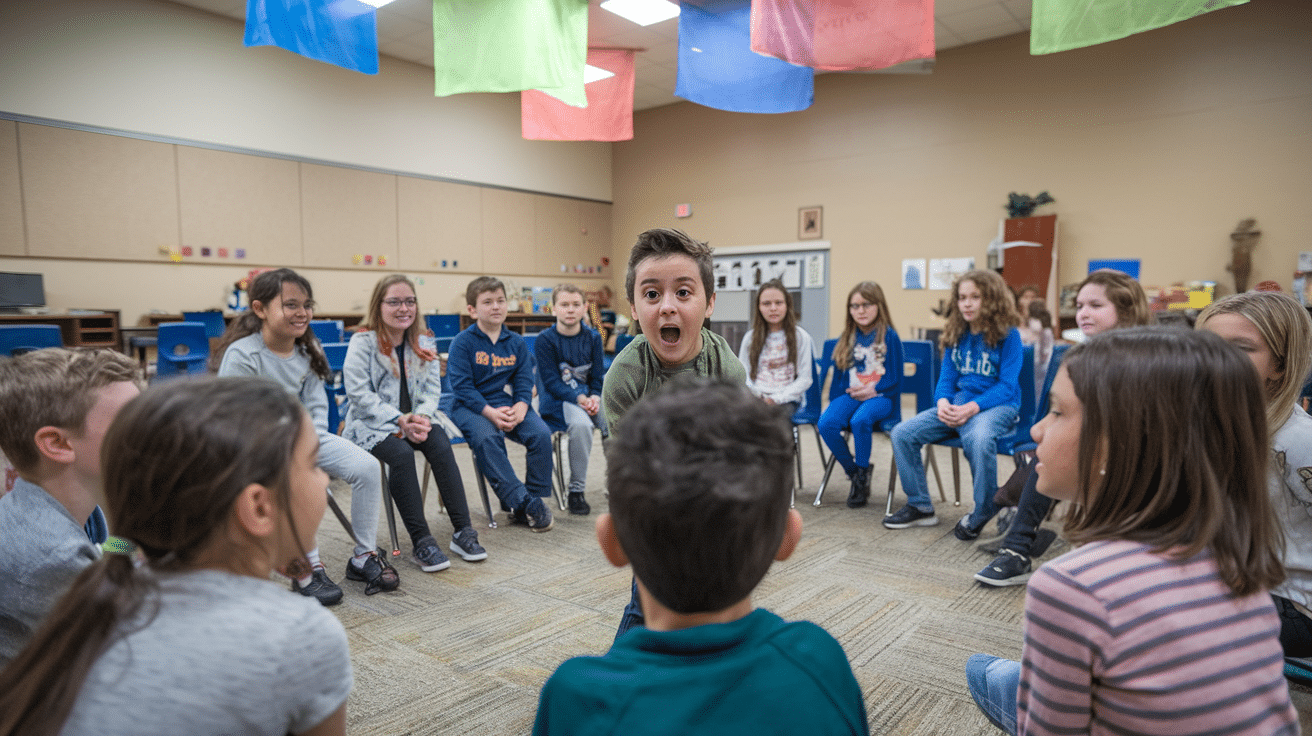Finding fun, engaging activities that work well in elementary classrooms can be tough. Kids need movement and play, but teachers also want them learning while they’re having fun.
It’s a tricky balance that many educators and parents struggle with daily.
Charades for elementary school offers a simple solution that brings laughter and learning together.
This classic game helps children build confidence, practice communication skills, and burn off energy – all without special equipment or lengthy prep time.
This blog will share how to run charades for elementary school settings, offer age-appropriate word lists, and explain the hidden educational benefits that make this more than just a good time.
Readers will get to know how this timeless game can bring joy to classrooms and homes.
The History of the Playful Act: Beginning of Charades
The roots of charades go back much further than many teachers and parents might think. This beloved classroom game began not as a children’s activity but as a sophisticated parlor game among French nobles in the 18th century.
Originally, charades took a different form than what we see in elementary schools today. Players would break a word into syllables, acting out each part separately. This word-puzzle approach made charades a test of both acting skill and word knowledge.
By the 19th century, the game had spread across Europe and to America, where it became a staple of social gatherings. Key moments in charades history include:
- 1800s: Charades became part of Victorian parlor entertainment, documented in books of games and amusements
- Early 1900s: The game shifted from syllable-based clues to acting out the entire word or phrase
- 1930s-40s: Charades found its way into summer camps and school settings
- 1960s-70s: Television shows like “Pantomime Quiz” brought charades to mass audiences
- 1980s-present: The game became a standard in elementary education as teachers noted its benefits
What began as entertainment for aristocrats became one of the most accessible games for young children. Its simplicity and adaptability helped charades survive through cultural changes that made other historical games obsolete.
Teachers today use essentially the same activity that brought laughter in candlelit parlors two centuries ago, proof that good ideas in education endure.
How to Play Charades with Elementary School Students

Setting up charades for elementary school students requires clear, simple rules. Here’s how to play this fun game with young children:
- Split the class or group into two teams. Small groups work best for younger children, as waiting too long for turns can lead to restlessness.
- Create word cards suited to the children’s age. For first and second graders, use animals, simple actions, or cartoon characters. Older elementary students can handle more complex ideas like book titles or movies.
- Place all word cards in a container. This could be a hat, box, or basket—anything that hides the cards from view.
- Decide which team goes first with a quick coin toss or by asking the teams to guess a number.
- The first player picks a card without showing it to anyone else. Give them a moment to think about how they’ll act it out.
- Set a time limit. For younger kids, one to two minutes works well. Use a timer that everyone can see.
- The player must act out the word or phrase without speaking or making sounds. Lip movements that hint at the word are not allowed.
- Players can point to objects in the room if needed but cannot spell out words with their fingers or use “sounds like” clues.
- The player’s team tries to guess the word within the time limit. Only guesses from their team count.
- If the team guesses correctly within the time limit, they earn a point. If not, the other team gets one chance to steal by making a single guess.
- Teams take turns, with each player getting a chance to act out a word.
- The first team to reach ten points wins or sets a fixed number of rounds if time is limited.
- For very young children, consider playing as one big group rather than competing teams, making it more about fun than winning.
Let’s Start The Act: Ideas for Charades
Charades is a classic game that brings excitement and laughter, making it an ideal activity for elementary school students. It encourages creativity, teamwork, and problem-solving as kids express ideas without words.
It doesn’t matter if you are at a party or in the classroom; this game promotes fun learning experiences.
Below, you’ll find a collection of 222 charades ideas, divided into categories to make it easy to pick and play!
Here is the full set of 222 charades ideas, organized into categories:
Easy and Cute Animal-Related Charades Idea

Elephant
Monkey
Alligator
Penguin
Snake
Frog
Lion
Butterfly
Kangaroo
Fish
Dog
Cat
Horse
Rabbit
Giraffe
Bee
Dolphin
Bear
Zebra
Peacock
Turtle
Owl
Rooster
Crocodile
Octopus
Common Objects Related Ideas

Telephone
Book
Television
Scissors
Sunglasses
Fan
Backpack
Umbrella
Camera
Computer
Pencil
Clock
Chair
Lamp
Mirror
Toothbrush
Globe
Kite
Microscope
Paintbrush
Helmet
Calculator
Flashlight
Telescope
Wheelbarrow
Day-to-Day Activities Related Ideas

Jumping on a trampoline
Flying a kite
Riding a bicycle
Walking a dog
Doing a puzzle
Drawing
Building a snowman
Skateboarding
Playing hide and seek
Building a sandcastle
Singing
Dancing
Cooking
Gardening
Fishing
Painting
Swimming
Climbing a tree
Playing the piano
Taking photographs
Acting in a play
Camping
Jogging
Reading a book
Be Your Future Self: Profession-Related Charades Idea

Doctor
Teacher
Firefighter
Chef
Farmer
Police officer
Construction worker
Nurse
Artist
Mechanic
Scientist
Librarian
Athlete
Singer
Dancer
Actor
Waiter
Photographer
Bus driver
Pilot
Soldier
Sailor
Baker
Plumber
Electrician
Gardener
Cleaner
Fantasy World: Making the Fairy Tale Come True

Cinderella
Snow White
Sleeping Beauty
Little Red Riding Hood
Pinocchio
Aladdin
Jack from Jack and the Beanstalk
Rumpelstiltskin
The Big Bad Wolf
Hansel and Gretel
Rapunzel
The Three Little Pigs
Peter Pan
Tinkerbell
Ariel
Simba
Beauty and the Beast
Elsa
Anna
Pocahontas
Mulan
Moana
Merida
School-Related Actions

Writing on the board
Reading a book
Giving a presentation
Asking a question
Taking a test
Drawing a picture
Playing with a pencil
Raising a hand
Putting away books
Eating lunch
Packing a bag
Playing on the playground
Running a race
Taking a nap
Painting
Doing math
Science experiment
Giving a speech
Walking to class
Playing sports
Writing in a notebook
School bell ringing
Doing homework
Answering a question
Giving a high-five
Doing a project
Using a calculator
Taking notes
Talking to friends
Playing hopscotch
Expecto Patronum: Famous Characters

Harry Potter
Hermione Granger
Ron Weasley
Darth Vader
Luke Skywalker
Yoda
Spiderman
Batman
Superman
Wonder Woman
Iron Man
Captain America
Thor
Hulk
Black Panther
The Joker
Deadpool
Aquaman
Flash
Wolverine
Catwoman
The Riddler
Harley Quinn
Spider-Gwen
Doctor Strange
The Flash
Green Lantern
Lex Luthor
Thanos
Venom
Groot
Rocket Raccoon
The Incredibles
Delicious Foods and Drinks Ideas

Pizza
Ice cream
Hamburger
Hot dog
Fries
Sandwich
Apple
Banana
Carrot
Broccoli
Strawberry
Grapes
Watermelon
Pancakes
Cupcake
Popcorn
Cake
Cookie
Lemonade
Milkshake
Juice
Tea
Coffee
Soup
Salad
Spaghetti
Pancakes
Donut
The Act of Teaching by Playing Charades
In elementary school settings, charades goes far beyond mere entertainment. This simple activity packs numerous educational benefits that support whole-child development while students laugh and play.
Physical education teachers value charades for its movement aspects.
When children act out concepts, they practice body control, spatial awareness, and coordination. For example, a student pretending to be a monkey must think about how monkeys move and then control their body to show those movements.
Communication skills flourish during charades sessions. Students must find ways to express ideas without words, which builds critical nonverbal communication abilities.
This helps children understand that communication extends beyond speaking; facial expressions, gestures, and body language all convey meaning, too.
Classroom teachers find charades helpful for academic reinforcement. The game can be adapted to practice vocabulary from any subject area:
- Science classes use animal behaviors or natural phenomena
- Social studies lessons incorporate historical figures or cultural traditions
- Language arts sessions feature book characters or story elements
- Math classes act out shapes, numbers, or measurement concepts
Emotional and social learning happens naturally during charades. Students practice taking turns, handling the spotlight, and supporting peers.
For shy children, acting without speaking sometimes feels less threatening than verbal participation. The game builds confidence as students see their classmates understand their actions.
Cognitive benefits include strengthened memory as children recall details about their assigned word.
Winding It Up
Charades for elementary school brings joy, movement, and learning together in one simple activity.
When students act out words with their bodies, they build skills across physical, social, and academic areas without even knowing they’re learning.
Teachers and parents can adjust the game to fit any group of children, making it useful for classroom lessons, rainy day fun, or family gatherings.
The lack of need for supplies makes it accessible to all.
In a world full of screens and structured activities, charades stands out as a breath of fresh air, a gentle reminder that sometimes the best learning happens when we put down our pencils, stand up from our desks, and let our bodies tell the stories our voices cannot.




